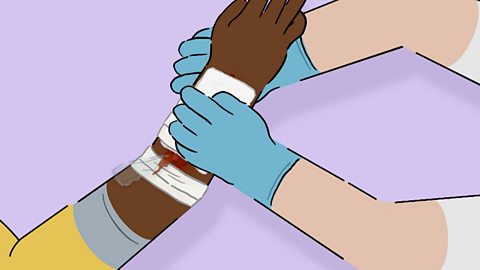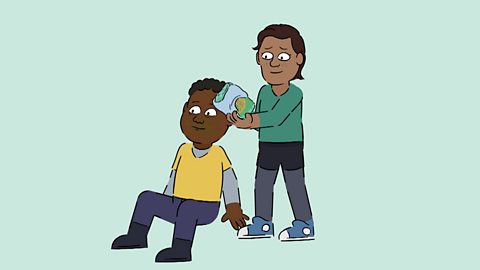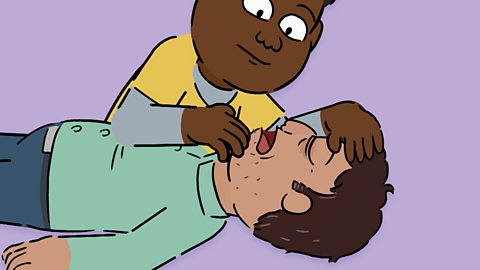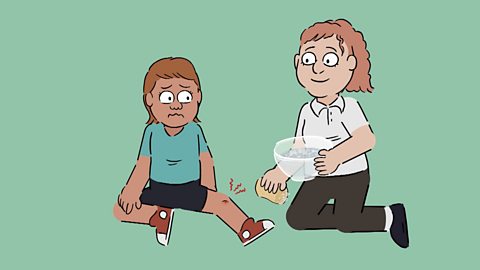Dr Emeka:
Hey, Iβm Dr Emeka and this is Dr Emekaβs Essential First Aid.
If you come across someone in danger. It is important that you know how to help and what information youβll need if you have to call emergency services.
But remember, the most important thing is your own safety. You donβt want to rush in and hurt yourself, or there will be two emergencies to deal with.
So if you come across an emergency the first thing to do is to check it is safe for you to approach. Is there anything around that could be dangerous? Is there a fire for example? Or something leaking? If so, stay back and call 999 or 112.
If it is safe to approach, check if they react to you talking to them or saying their name. Then call 999 or 112. The operator on the phone will ask you which emergency service you need β fire, police or ambulance. Try and answer their questions as best you can; tell them what has happened, who is involved in the incident and the address or location of where you are.
Reassure the injured person. Keep calm. Let them know help is on the way and stay with them until it arrives.If you have been taught first aid, nowβs the time to use it!
REMEMBER
Check for danger.
Call 999 or 112.
Reassure those youβre with.
Use your first aid if it is needed.
Video summary
A short film teaching pupils how to recognise an emergency and how to make a call to emergency services.
With the help of animated explanations, Dr Emeka outlines how to recognise an emergency (and how to understand when it isnβt an emergency).
He goes through the process of calling the emergency services on the phone and understanding what will be asked of you when you do.
This short film is from the ΒιΆΉΤΌΕΔ Teach series 'Dr Emekaβs Essential First Aid'.
Teacher Notes
Pupils could learn and acknowledge the LIONEL system that will help them to know what details will be asked of them when they are on the phone to the emergency services.
L - Location - tell them where the emergency is and where they need to come to.I - Incident - tell them what has happened.
O - Other services - do you need the ambulance and fire service?N - Number of people - how many are there involved?
E - Extent of injuries - how badly are they hurt?L - Location - repeat again where they need to come to.
Students should understand that 999 and 112 are both numbers for the emergency services, but 999 is exclusively for use in the UK and 112 can be used in the UK and across Europe (and further) to reach the local emergency services.
Activities
Students could be given scenarios and asked whether or not it is an emergency that would require the emergency services.
Students could be asked to recognise possible hazards in an image of an emergency by marking them, or pointing them out.
Pupils could role play different scenarios that would help them to understand which emergency service they need (fire, police or ambulance). They could also role play being on the phone as a person in an emergency and the emergency services operator, in order to understand what questions will be asked of them.
Students could list three locations that they know and say the address for each one.
Students could practise explaining where they are if they donβt know the address - recognising what is near them and explaining what they can see. They could practise using three key words in order to do so.
In pairs, students could describe an area to their partner, without using an address, who then has to guess the location they are talking about.
Other subject areas
Students could learn how to roleplay and improvise, taking on the persona of someone in an emergency, or an operator on the end of the phone.
In geography students could begin to understand maps and how an address helps us identify a location. They could also learn about how local landmarks help you identify an area.
This short film touches on elements of PSHE first aid as introduced to the curriculum in England from September 2020 for Key Stage 2.
While not on the curriculum specifically, it could also be used in Wales and Northern Ireland at Key Stage 2 and in Scotland at 1st and 2nd level.
Burns and scalds. video
Dr Emeka gives an introduction to dealing with the types of burns and scalds that can occur in domestic settings.

Choking. video
In this short film Dr Emeka gives an introduction for pupils on how to help someone who is choking.

Bleeding and shock. video
Dr Emeka explains how to treat bleeding wounds, what shock is and what to do if someone goes into shock.

Head injuries. video
In this short film Dr Emeka explains how to tell if a head injury is minor or severe, and what to do in each situation.

Bone fractures. video
In this short film Dr Emeka explains to how to manage a broken or suspected broken bone.

How to administer CPR. video
In this short film, Dr Emeka introduces the process for administering CPR and how to use an AED (automated external defibrillator).

How to administer CPR during the Covid-19 pandemic. video
In this short film Dr Emeka introduces the process for administering CPR and how to use an AED (automated external defibrillator), with specific tips for staying safe during the Covid-19 pandemic.

Bites and stings. video
In this short film Dr Emeka teaches pupils how to deal with bites and stings on themselves, or those around them.
